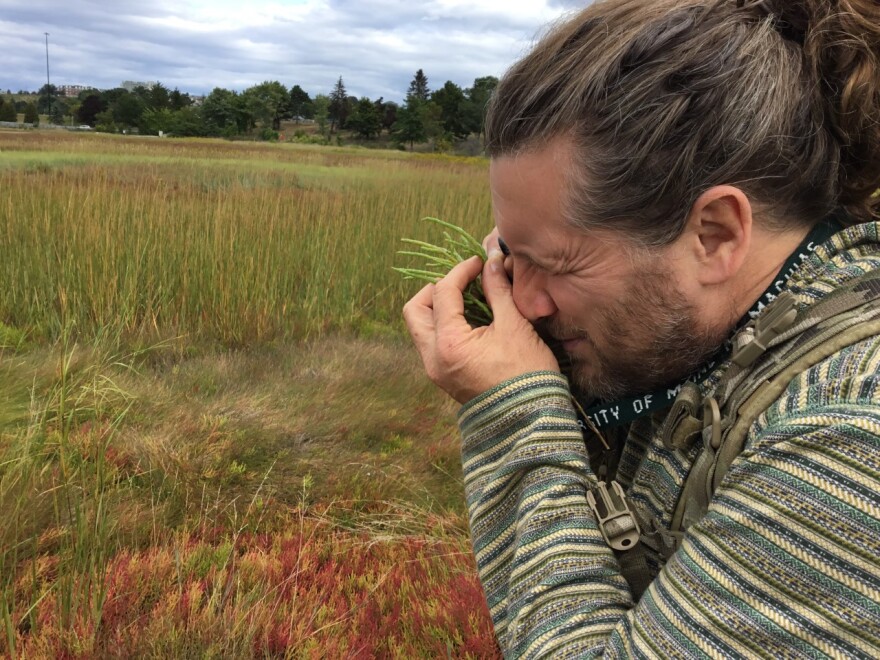Maine is now home to dozens of invasive species of plants and insects. These are species that didn’t evolve here, and now they’re threatening plants that did. And that threat extends to the native insects, birds and other living things that depend on those plants.
The changes, driven by a warming climate and other factors, endanger long-established ecosystems in Maine and across New England. But efforts are underway to protect and preserve the region's native plants.

Nearly 350 species of plants native to Maine are now considered rare, and several are “critically imperiled,” with only a handful of plants known to exist. Botanist Arthur Haines can identify every single one of them, along with the more than 2,000 other species that are native to Maine.
“This is called glasswort, its common name,” he says, bending low to the ground and plucking a fernlike fragment. He peers at it through a nickel-size magnifying glass. “It has a tiny little fruit that looks like a seed. And that’s it — just this tiny little thing that drops out, primarily by gravity, and starts the new population. This is an annual. So, it’s entirely dependent on all of those fruits produced each year.”

Haines is a Maine-based research botanist with the Native Plant Trust, a Framingham, Massachusetts-based nonprofit with a mission to save New England’s native plants by preserving their habitats and collecting and saving their seeds.
On this warm, late summer day, we’re in a field along the shore of Portland’s Back Cove. Across the street is a Hannaford Supermarket, and nearby cars whiz along Interstate 295.
Despite that, Haines says glasswort, a type of amaranth, thrives in places like Back Cove because it’s adapted to saltier environments. But towering over the glasswort is another plant native to Europe and Asia. Haines says it’s called phragmites australis, or common reed.

“And it loves these places at the edges of brackish and saline marshes, like you see here, where it fills in in dense colonies,” Haines says. “And the problem with it, of course, is it crowds out all the other vegetation to form these almost monocultures of really tall grass that you’re looking at.”
That’s bad news for Back Cove’s native plants, Haines says, and for its populations of native insects and birds.

“Studies have shown that our native species of plants are essentially more palatable to the insects that are found here, and offer more foraging opportunities for the songbirds,” he says. “The non-native species are not used anywhere near as much. So, without supporting insects they’re actually not supporting songbirds.”
Recent studies have documented steep global declines in populations of insects and birds. Saving the native plants they depend on can help stem and, perhaps one day, reverse those losses, says the Native Plant Trust’s conservation director Michael Piantedosi.
Part of that effort, he says, is preserving places where rare plants can grow undisturbed, like the 177-acre Coffin Wild Flower Reservation in Woolwich that we’re hiking through on this sunny, late summer day.
“It abuts Merrymeeting Bay, as you can see from this fabulous view,” Piantedosi says. “And this bay and these mudflats are home to maybe half a dozen rare species in Maine and the Northeast.”

Some so rare, he says, he’d rather keep their location here a secret. The Coffin Wild Flower Reservation is one of six “native plant sanctuaries” the Trust operates in New England. Two others are in Maine, in Springvale and Vassalboro. The sanctuaries provide habitat for native plants, Piantedosi says, and where native plants thrive, the ecosystem is more resilient to the effects of climate change.
“At a place like this, in particular, somewhere like Merrymeeting Bay, sea level rise and high-energy storms on the coastline are going to impact these habitats,” he says. “Over time they erode, and floods get worse and worse. So, whatever we can do to stem that by using the species that occur here the better off we are.”

Stemming those impacts also involves saving the seeds of species that are in danger of disappearing, Piantedosi says. That’s done by a network of hundreds of volunteers, scientists and staffers who collect seeds from rare plants growing on New England’s mountaintops, rocky coastal outcrops, forests, riverbanks and other ecosystems. The seeds are painstakingly prepared and stored in a super-cold vault in Framingham, Massachusetts.
“The seed bank is, basically, an insurance policy for those rare and endangered species. It is the reserve that we would use in the event of a catastrophic event,” Piantedosi says. “We don’t want to have to use them. We don’t want to have to maintain a seed bank. But, clearly, in response to habitat loss, and species range shifts and species loss, we have to.”

Here at the Coffin reserve, all of the plants Piantedosi has seen so far are native to the region. But on the way back to the parking lot, he spots an outlier — a plant European settlers brought to the New World.
“Wood sorrel,” he says. “You’ve seen this. This is in every parking lot you’ve ever been to, probably. It’s the only European species I’ve seen here.”
But it’s not likely to be the last. Today, more than 30% of the plants on New England’s landscape are not native, according to a Trust assessment. In Maine, much of the native landscape still remains intact, says botanist Arthur Haines. The challenge, he says, is to keep it that way.
This story is part of a week-long reporting project Covering Climate Now by Maine Public and more than 300 other news outlets around the world. The series comes in advance of the United Nations Climate Action Summit on Monday Sept. 23 in New York. More information here.






